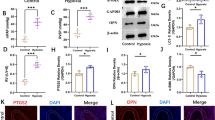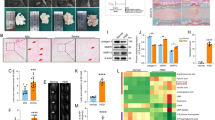Abstract
Hypoxia-inducible factor-1α (HIF-1α) protein is degraded under normoxia by its association to von Hippel-Lindau protein (pVHL) and further proteasomal digestion. However, human renal cells HK-2 treated with 15-deoxy-Δ12,14-prostaglandin-J2 (15d-PGJ2) accumulate HIF-1α in normoxic conditions. Thus, we aimed to investigate the mechanism involved in this accumulation. We found that 15d-PGJ2 induced an over-accumulation of HIF-1α in RCC4 cells, which lack pVHL and in HK-2 cells treated with inhibitors of the pVHL-proteasome pathway. These results indicated that pVHL-proteasome-independent mechanisms are involved, and therefore we aimed to ascertain them. We have identified a new lysosomal-dependent mechanism of HIF-1α degradation as a target for 15d-PGJ2 based on: (1) HIF-1α colocalized with the specific lysosomal marker Lamp-2a, (2) 15d-PGJ2 inhibited the activity of cathepsin B, a lysosomal protease, and (3) inhibition of lysosomal activity did not result in over-accumulation of HIF-1α in 15d-PGJ2-treated cells. Therefore, expression of HIF-1α is also modulated by lysosomal degradation.







Similar content being viewed by others
References
Jaakkola P, Mole DR, Tian YM, Wilson MI, Gielbert J, Gaskell SJ, Kriegsheim AA, Hebestreit HF, Mukherji M, Schofield CJ, Maxwell PH, Pugh CW, Ratclife PJ (2001) Targeting of HIF-α to the von Hippel-Lindau ubiquitylation complex by O2-regulated prolyl hydroxylation. Science 292(5516):468–472
Ivan M, Kondo K, Yang H, Kim W, Valiando J, Ohh M, Salic A, Asara JM, Lane WS, Kaelin WG Jr (2001) HIFalpha targeted for VHL-mediated destruction by proline hydroxylation: implications for O2 sensing. Science 292(5516):464–468
Masson N, Willam C, Maxwell PH, Pugh CW, Ratcliffe PJ (2001) Independent function of two destruction domains in hypoxia-inducible factor-α chains activated by prolyl hydroxylation. EMBO J 20:5197–5206
Hirsila M, Koivunen P, Gunzler V, Kivirikko KI, Myllyharju J (2003) Characterization of the human prolyl 4-hydroxylases that modify the hypoxia-inducible factor. J Biol Chem 278(33):30772–30780
Yu F, White SB, Zhao Q, Lee FS (2001) HIF-1alpha binding to VHL is regulated by stimulus-sensitive proline hydroxylation. Proc Natl Acad Sci USA 98(17):9630–9635
Lando D, Peet DJ, Whelan DA, Gorman JJ, Whitelaw ML (2002) Asparagine hydroxylation of the HIF transactivation domain: a hypoxic switch. Science 295(5556):858–861
Matsumoto M, Makino Y, Tanaka T, Tanaka H, Ishizaka N, Noiri E, Fujita T, Nangaku M (2003) Induction of renoprotective gene expression by cobalt ameliorates ischemic injury of the kidney in rats. J Am Soc Nephrol 14(7):1825–1832
Guo G (2004) Improvement of kidney function in a rat model of renal ischemia-reperfusion injury by treatment with a novel HIF prolyl-hydroxylase inhibitor. ASN annual meeting, St Louis MO. J Am Soc Nephrol 15:460A
Chatterjee PK, Patel NS, Cuzzocrea S, Brown PA, Stewart KN, Mota-Filipe H, Britti D, Eberhardt W, Pfeilschifter J, Thiemermann C (2004) The cyclopentenone prostaglandin 15-deoxy-Δ 12, 14-prostaglandin-J2 ameliorates ischemic acute renal failure. Cardiovasc Res 61:630–643
Olmos G, Conde I, Arenas MI, Del Peso L, Castellanos C, Landazuri MO, Lucio-Cazana FJ (2007) Accumulation of hypoxia-inducible factor-1α through a novel electrophilic, thiol antioxidant-sensitive mechanism. Cell Signal 19:2098–2105
Flügel D, Görlach A, Michiels C, Kietzmann T (2007) Glycogen synthase kinase 3 phosphorylates hypoxia-inducible factor 1α and mediates its destabilization in a VHL-independent manner. Mol Cell Biol 27:3253–3265
Liu YV, Baek JH, Zhang H, Diez R, Cole RN, Semenza GL (2007) RACK1 Competes with HSP90 for Binding to HIF-1α and is Required for O2-independent and HSP90 Inhibitor-induced Degradation of HIF-1α. Mol Cell 25:207–217
Qian DZ, Kachhap SK, Collis SJ, Verheul HMW, Carducci MA, Atadja P, Pili R (2006) Class II histone deacetylases are associated with VHL-independent regulation of hypoxia-inducible factor 1A. Cancer Res 66:8814–8821
Isaacs JS, Jung Y, Mimnaugh EG, Martine ZA, Cuttitta F, Neckers LM (2002) Hsp90 regulates a von Hippel Lindau-independent hypoxia-inducible factor-1α-degradative pathway. J Biol Chem 277:29936–29944
Zhou J, Köhl R, Herr B, Frank R, Brüne B (2006) Calpain mediates a von hippel-lindau protein–independent destruction of hypoxia-inducible factor-1α. Mol Cell Biol 17:1549–1558
Im E, Venkatakrishan A, Kazlauskas A (2005) Cathepsin B regulates the intrinsic angiogenic threshold of endotelial cells. Mol Biol Cell 16:3488–3500
Waters SL, Sarang SS, Wang KKW, Schnellmann RG (1997) Calpain mediate calcium and chloride influx during the late phase of cell injury. J Pharmacol Exp Ther 117:7–1184
Wu TY, Tan HL, Huang Q, Kim YS, Pan N, Ong WY, Liu ZG, Ong CN, Shen HM (2008) Autophagy plays a protective role during zVAD-induced necrotic cell death. Autophagy 4:457–466
Kong W, Alvarez-Castelao B, Lin ZJ, Castano JG, Caro J (2007) Constitutive/Hypoxic Degradation of HIF-α Proteins by the Proteasome Is Independent of von Hippel Lindau Protein Ubiquitylation and the Transactivation Activity of the Protein. J Biol Chem 282:15498–15505
Stamatakis K, Sanchez-Gomez FJ, Perez-Sala D (2006) Identification of novel protein targets for modification by 15-deoxy-Δ12, 14-prostaglandin-J2 in mesangial cells reveals multiple interactions with the cytoskeleton. J Am Soc Nephrol 17:89–98
Schotte P, Schauvliege R, Janssens S, Beyaert R (2001) The cathepsin B inhibitor z-FA.fmk inhibits cytokine production in macrophages stimulated by lipopolysaccharide. J Biol Chem 276:21153–21157
Guicciardi ME, Deussing J, Miyoshi H, Bronk SF, Svingen PA, Peters C, Kaufmann SH, Gores G (2000) Cathepsin B contributes to TNFalpha-mediated hepatocyte apoptosis by promoting mitochondrial release of cytochrome c. J Clin Invest 106:1127–1137
Riccio M, Di Giaimo R, Pianetti S, Palmieri PP, Melli M, Santi S (2001) Nuclear localization of cystatin B, the cathepsin inhibitor implicated in myoclonus epilepsy (EPM1). Exp Cell Res 262:84–94
Lee DH, Goldberg AL (1998) Proteasome inhibitors: valuable new tools for cell biologists. Trends Cell Biol 8:397–403
Fuertes G, Martín de Llano JJ, Villarroya A, Rivett A, Knecht E (2003) Changes in the proteolytic activities of proteasomes and lysosomes in human fibroblasts produced by serum withdrawal, amino-acid deprivation and confluent conditions. Biochem J 375:75–80
Kisselev AF, Callard A, Goldberg AL (2006) Importance of the different proteolytic sites of the proteasome and the efficacy of inhibitors varies with the protein substrate. J Biol Chem 281:8582–8590
Li Z, Melandri F, Berdo I, Jansen M, Hunter L, Wright S, Valbrun D, Figueiredo-Pereira M (2004) Δ12-prostaglandin J2 elicits ubiquitin-protein aggregation without proteasome inhibition. Biochem Biophys Res Commun 319:1171–1180
Branca D (2004) Calpain-related diseases. Biochem Biophys Res Commun 322:1098–1104
Shibata T, Yamada T, Kondo M, Tanahashi N, Tanaka K, Nakamura H, Masutani H, Yodoi J, Uchida K (2003) An endogenous electrophile that modulates the regulatory mechanism of protein turnover: inhibitory effects of 15-deoxy-Delta12, 14-prostaglandin-J2 on proteasome. Biochemistry 42(47):13960–13968
Levonen AL, Landar A, Ramachandran A, Ceaser EK, Dickinson DA, Zanoni G, Morrow JD, Darley-Usmar VM (2004) Cellular mechanisms of redox cell signaling: the role of cysteine modification in controlling antioxidant defenses in response to electrophilic lipid oxidation products. Biochem J 378:373–382
Sanchez-Gomez FJ, Cernuda-Morollon E, Stamatakis K, Perez-Sala D (2004) Protein thiol modification by 15-deoxy-Δ12, 14-prostaglandin J2 addition in mesangial cells: role in the inhibition of pro-inflammatory genes. Mol Pharmacol 66(5):1349–1358
Lorente M, Mirapeix RM, Miguel M, Longmei W, Volk D, Cervós-Navarro J (2002) Chronici hypoxia induced ultrastructural changes in the rat adrenal zona glomerulosa. Histol Histophathol 17(1):185–190
Welt K, Fitzl G, Schepper A (2001) Experimental hypoxia of STZ-diabetic rat myocardium and protective effects of Ginkgo biloba extrac. II. Ultrastructura investigation of microvascular endothelium. Exp Toxicol Pathol 52(6):503–512
Massey A, Kiffin R, Cuervo AM (2004) Pathophysiology of chaperone-mediated autophagy. Int J Biochem Cell Biol 36:2420–2434
Agarraberes F, Dice J (2001) A molecular chaperone complex at the lysosomal membrane is required for protein translocation. J Cell Sci 114:2491–2499
Kiffin R, Christian C, Knecht E, Cuervo AM (2004) Activation of chaperone-mediated autophagy during oxidative stress. Mol Biol Cell 15:4829–4840
Katschinsk D, Le L, Schindler S, Thomas T, Voss A, Wenger R (2004) Interaction of the PAS B Domain with HSP90 Accelerates Hypoxia-Inducible Factor-1α Stabilization. Cell Physiol Biochem 14:4–6
Zheng X, Ruas JL, Cao R, Salomons FA, Cao Y, Poellinger L, Pereira T (2006) Cell-type-specific regulation of degradation of hypoxia-inducible factor 1 alpha: role of subcellular compartmentalization. Mol Cell Biol 26:4628–4641
Khan Z, Michalopoulos GK, Stolz DB (2006) Peroxisomal localization of hypoxia-inducible factors and hypoxia inducible factor regulaoty hydroxylases in primary rat hepatocytes exposed to hypoxia-reoxigenation. Am J Pathol 169(4):1251–1269
Liu Q, Berchner-Pfannschmidt U, Moller U, Brecht M, Wotzlaw C, Acker H, Jungermann K, Kietzmann T (2004) Fenton reaction at the endoplasmic reticulum is involved in the redox control of hypoxia-inducible gene expression. Proc Natl Acad Sci USA 101:4302–4307
Kidane TZ, Sauble E, Linder MC (2006) Release of iron from ferritin requires lysosomal activity. Am J Physiol 291:C445–C455
Cernuda-Morollon E, Pineda-Molina E, Canada FJ, Perez-Sala D (2001) 15-Deoxy-Delta 12, 14-prostaglandin J2 inhibition of NF-kappaB-DNA binding through covalent modification of the p50 subunit. J Biol Chem 276(38):35530–35536
Strauss DS, Glass CK (2001) Cyclopentenone prostaglandins: new insights on biological activities and cellular targets. Med Res Rev 21(3):185–210
Liu JD, Tsai SH, Lin SY, Ho YS, Hung LF, Pan S, Ho FM, Lin CM, Liang YC (2004) Thiol antioxidant and thiol-reducing agents attenuate 15-deoxy-delta 12, 14-prostaglandin J2-induced heme oxygenase-1 expression. Life Sci 74:2451–2463
Benesic A, Schwerdt G, Freudinger R, Mildenberger S, Groezinger F, Wollny B, Kirchhoff A, Gekle M (2006) Chloroacetaldehyde as a sulfhydryl reagent: the role of critical thiol groups in ifosfamide nephropathy. Kidney Blood Press Res 29:280–293
Acknowledgments
This work was supported by grants SAL-0311-2006 from the Comunidad de Madrid, SAF2008-01767 from the Spanish Ministerio de Ciencia e Innovación and CCG08-UAH/BIO-4102 from University of Alcala.
Author information
Authors and Affiliations
Corresponding author
Rights and permissions
About this article
Cite this article
Olmos, G., Arenas, M.I., Bienes, R. et al. 15-Deoxy-Δ12,14-prostaglandin-J2 reveals a new pVHL-independent, lysosomal-dependent mechanism of HIF-1α degradation. Cell. Mol. Life Sci. 66, 2167–2180 (2009). https://doi.org/10.1007/s00018-009-0039-x
Received:
Revised:
Accepted:
Published:
Issue Date:
DOI: https://doi.org/10.1007/s00018-009-0039-x




